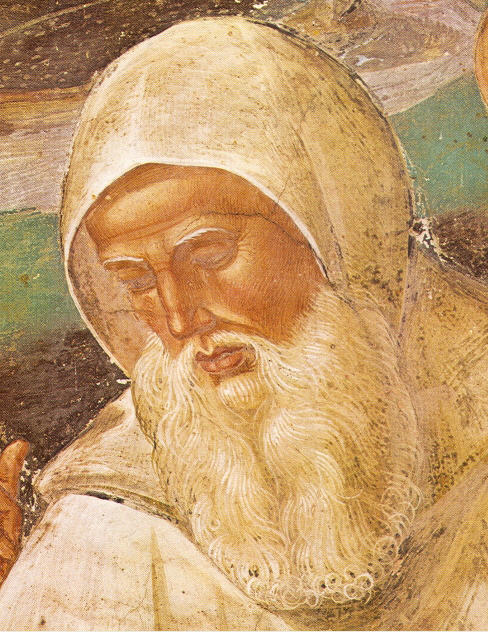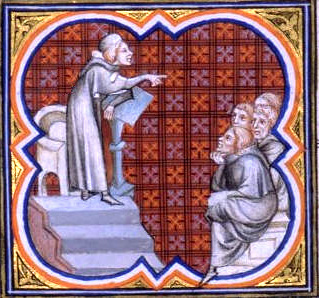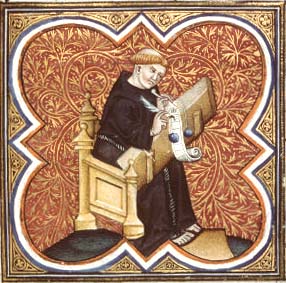MEPKIN
MONASTIC
INSTITUTE
2018
.

St. Benedict.
Sodoma, 1508. Monteoliveto,
|
. |
St. Benedict. |
 |
MEPKIN |
v MONASTICISM, BENEDICT and THE RULE
v FRIENDSHIP in MONASTIC COMMUNITY
v SOLITUDE & COMMUNITY (Hermitage and Cenobium)
v CARE of the SICK and VULNERABLE
v LITURGICAL LIFE: Psalmody; Liturgical Prayer
v SPIRITUAL PRACTICE and CONTEMPLATIVE PRAYER
v DIVINIZATION in the RULE and LIFE of BENEDICT
 |
MEPKIN |
v MONASTICISM, BENEDICT and THE RULE
RB 80 The Rule of St. Benedict in Latin and English with Notes, (Liturgical Press, 1980)
Adalbert de Vogüé, The Rule of Saint Benedict, A Doctrinal and Spiritual Commentary, (Cist.Studies #54, 1983)
Delatte, P. The Rule of St. Benedict, A Commentary, tr. J. McCann. London: Burns Oates 1921.
Van Zeller, H. The Holy Rule. Notes on St. Benedict's Legislation for Monks. New York: Sheed and Ward 1958.
Chadwick, O. The Rule of St. Benedict in Western Asceticism, The Library of Christian Classics. (Philadelphia: Westminster 1958)
Derwas Chitty, The Desert A City.
Knowles, D. Christian Monasticism. New York: McGraw-Hill 1967.
Farmer, D.H. Benedict's Disciples, (Gracewing, repr. 2002)
Benedicta Ward, The Sayings of the Desert Fathers.(Cistercian Pub., 1987)
─ Harlots of the Desert, A Study of Repentance in Early Monastic Sources, (Cistercian Pub., 1987).
Ancient Christian Writers (Paulist Press); Ante‑Nicene, Nicene, and Post‑Nicene Fathers (Eerdmans: download from Christian Classics Ethereal Library at http://www.ccel.org)
Louth, Andrew, The Origins of the Christian Mystical Tradition from Plato to Pseudo-Dionysius, (Clarendon, Oxford University Press, 1981).
Columba Stewart, Prayer and Community, (Orbis Books, 1998) ISBN: 1570752192
Rees, D. (ed.) Consider Your Call. London: SPCK 1978.
Marmion, C. Christ the Ideal of the Monk. St. Louis: Herder 1922. A theological presentation of the spiritual foundation of monastic life.
Merton, T. Contemplation in a World of Action. New York: Doubleday Image Books 1973.
Bouyer, L. The History of Christian Spirituality, vol. 1, Spirituality of the New Testament and the Fathers, tr. M.P. Ryan. New York: Desclée 1963.
Butler, C. Benedictine Monachism: Studies in Benedictine Life and Rule. London: Longmans, Green and Co. 1919.
v FRIENDSHIP in MONASTIC COMMUNITY
Liz Carmichael, Interpreting Christian Love (T&T Clark/Continuum, 2004) ISBN 0567080722.
C. S. Lewis, The Screwtape Letters, (Harper/Collins, repr. 2015), The Great Divorce, (Harper/Collins, repr. 2015), The Four Loves (Harper/Collins, repr. 2015),
Brian Patrick McGuire, Friendship and Community:, the Monastic Experience 350–-1250 (Cistercian Pub., 1988).
v SOLITUDE & COMMUNITY (Hermitage and Cenobium)
v CARE of the SICK and VULNERABLE
v LITURGICAL LIFE: Psalmody; Liturgical Prayer
v SPIRITUAL PRACTICE and CONTEMPLATIVE PRAYER
Gabriel Bunge, Earthen Vessels: The Practice of Personal Prayer According to the Patristic Tradition tr. Michael Miller, (Ignatius Press, March 2002) ISBN: 0898708370
Mary Margaret Funk, Tools Matter for Practicing the Spiritual Life, (Continuum 2004)). ISBN: 0826416551
Leclercq, J. The Love of Learning and the Desire for God, tr. C. Misrahi. New York: Fordham Univ. Press 1961.
v DIVINIZATION in the RULE and LIFE of BENEDICT
Two questions prospective guests and retreatants often pose:
1. does the monastery offer Spiritual Exercises;
2. do the monks provide spiritual direction?
From the Introduction to:
EARLY
MONASTIC
EXEGESIS:
THE BASIS
of
SPIRITUAL
EXERCISE
and
SPIRITUAL
DIRECTION
Studia
Anselmiana, Analecta Monastica
9,
2009, pp. 423-44
Whole Article: MS-Word_DOC; PDF-FILE_FORMAT
In my own monastery of Saint Andrew’s Abbey in Valyermo, California, and I suspect in most communities with active ministries of hospitality, there are two questions prospective guests and retreatants often pose: first, does the monastery offer Spiritual Exercises; and second, do the monks provide spiritual direction? While most nuns and monks who follow the Rule of Benedict happily answer “yes” to the question concerning spiritual direction, the quasi-technical term “spiritual exercise” sometimes gives us pause. We presume that the questioner wishes to know whether we offer 30-day Ignatian retreats, and we thus restrict the focus of our answer to whether our community includes an expert in Ignatian spirituality. It would be very helpful if we were to expand our definition of “spiritual exercise” to include elements from the early monastic tradition that can profitably be shared with retreatants and that are readily available within the daily monastic horarium, elements that also provided the basis for early monastic spiritual direction.
An expanded approach to spiritual exercise does not entail a new or revisionist definition, but rather a return to an older and more comprehensive understanding of this concept. In his article in the Dictionnaire de spiritualité Jean Leclercq suggests two semantic ranges for this term during the early centuries of Christian monasticism:
first, exercitium in the literature of early Latin monasticism refers broadly to the twofold labor of asceticism and contemplation.
Second, and more specifically, “spiritual exercise” often served as a synonym for meditatio, the memorization and repetition of biblical texts, especially of the Psalter, in order to contemplate in the sacred text the One Who originally inspired it. [1]
One insight modern monks and nuns can draw from Leclercq’s first definition is that the term “spiritual exercise” in early monasticism highlights the interrelationship between all elements that comprise the monastic day. There is relatively little concern with distinctions between different ascetical practices or “methods” of meditation: instead, the emphasis is on their interconnectedness. Exercitium was not separable from, but was, rather, fully integrated into the monastic horarium; indeed, according to Leclercq’s first definition, “spiritual exercise” is nearly identical with the varied and interrelated cycles that comprise the monastic day. The interwoven rhythms of psalmody and prayer, of work interspersed with contemplative study, of communal celebration and solitary meditation, gradually initiate the monastic practitioner into the twin arts of theoria physiké, the contemplation of God in creation, and theologia, intuition of the divine nature beyond all words and concepts.[2] “Spiritual exercise” thus entails an oscillating rhythm between ascetical practice and spiritual vision.
Leclercq’s second, more focused definition highlights the centrality of meditatio, the constant, inward repetition of memorized biblical texts or whole psalms. This fundamental practice underlies, accompanies, and draws from nearly every other element of the monastic day. The texts employed in meditatio, (or meleté as it was called in the Greek monastic tradition), were themselves the fruit of other related monastic practices: they could arise from the monks’ private lectio divina or from the corporate psalmody of the divine office; or they might be the precious gift of an abba or amma who had prescribed their use in response to the disciple’s plea “Give me a word!”.[3]
An insight we can profitably reappropriate is the ancient conviction that this exercitium leads to theoria physiké, the great art of contemplating God within creation. In early monastic tradition theoria physiké begins with rumination on the sacred text, and progresses into what may be termed “contemplative exegesis”, the art of perceiving beneath the letter of Sacred Scripture the designs, purposes, and loving presence of the Triune God. This is accomplished through prayerful, allegorical interpretation of sacred scripture coupled with the conviction that the ordinary events of daily life (ta pragmata) imprinted in memory and imagination can also serve as “text” for such exegesis. This approach is very ancient. In the writings of Philo of Alexandria fundamental components of such contemplative exegesis can be seen to predate not only Christian monasticism, but even Christianity itself. Nevertheless, it would not be wrong to describe this method also as “monastic exegesis”. Two modern scholars, Jean Leclercq and Peter Brown, have particularly emphasized the monastic character and origins of this practice.
In his book, The Love of Learning and the Desire for God Leclercq describes the evolution of a cultura Dei, a rich medieval “monastic culture” devoted to a “literature of transcendence” with a primarily eschatological character. This monastic culture was both rooted in and exemplified by an approach to reading and interpreting the sacred text that was oriented towards an experience of “compunction”, which Leclercq defines as “longing for Heaven”.[4] This anagogical monastic exegesis is the fruit of monastic lectio divina, the slow pondering of biblical text that seeks not so much information as personal experience of God, the author of the sacred text. During the medieval period with which Leclercq is chiefly concerned in The Love of Learning and the Desire for God, the practice of lectio divina would have occupied a Benedictine monk or nun, depending on the season of the year, for perhaps between two and three hours per day. And in the early centuries of Christian monasticism with which we shall be principally concerned in this article, that is the late fourth and early fifth centuries of Evagrius Ponticus and John Cassian, the practices of lectio/meditatio, anagnosis/meleté, would, in different forms, have occupied an even larger proportion of the monk’s waking day.
In The Body and Society Peter Brown emphasizes the monastic art of learning to read the “book of the heart” This he does by contrasting the pre-monastic Christian practice of spiritual exegesis typified by Origen and his disciples with that of the Desert Fathers:
[…] The desert became
the powerhouse of a new culture. [Whereas …] Origen’s spirituality
[…] often assumed philological resources
that could be found only in upper-class circles, in close proximity to great
cities[;] in the Life of Anthony, and in successive layers of monastic
spiritual guidance, we can detect the emergence of an alternative. The monk’s
own heart was the new book. What required infinitely skilled exegesis and long
spiritual experience were the “movements of the heart,” and the strategies and
snares that the Devil laid within it. The shift from a culture of the book to a
cultura Dei, based largely
on the nonliterate, verbal interchange of a monastic “art of thought,” was
rightly hailed as the greatest and the most peculiar achievement of the Old Men
of Egypt: it amounted to nothing less than the discovery of a new alphabet of
the heart.[5] […]
Thus with the help of Leclercq, and Brown we may identify early monastic spiritual exercise both with the larger symphonic rhythm of ascesis and contemplation that comprises the monastic day, and also with the underlying leitmotiv of intertwining lectio divina and contemplative exegesis. Such exegesis of biblical and personal salvation-history in turn facilitates the ability to perceive God in nature and in history; and for those entrusted with the ministry of spiritual guidance it enables the stories of struggle and faith that constitute the narrative matter of spiritual direction also to be perceived as matter for contemplation.
[1] J. Leclercq. Dictionnaire de spiritualité vol. 4/2 (Beauchesne, 1961), col. 1903-1908, esp. 1904, 1908.
[2] Evagrius, Praktikos 1; Cassian, Conference 14.1.3.
[3] Cassian provides what may be the most famous instance of this in Conferences 9 and 10, where Abba Isaac carefully trains Cassian and Germanus to treasure and use in monologistic prayer Psalm 70:2, Deus in adiutorium meum intende, Domine ad adiuvandum me festina.
[4] J. Leclercq, The Love of Learning and the Desire for God, A Study in Monastic Culture”, tr. C. Misrahi, (Fordham Univ.Pr., New York, 1961), pp. 55-56; 87.
[5] Peter Brown. The Body and Society, Men, Women, and Sexual Renunciation in Early Christianity, Chapter 11, «The Desert Fathers: Anthony to John Climacus» (Columbia Univ. Pr., New York, 1988), p. 229.
HOLINESS
/
THEOSIS
/ DIVINIZATION
|
|
v Spirituality and Mystical Theology - Theosis
v To contemplate the Other in the Light of Christ
from the
CATECHISM
of the CATHOLIC
CHURCH
I,3,I,1. on The Creed: Was conceived by the power of the Holy Spirit and was born of the Virgin Mary. Question: “why did the Word become flesh?” [457: to save us; 458: so that we might know God’s love; 459: to be our model of holiness]
460 The Word became flesh to make us “partakers of the divine nature”: (2 Pet 1:4) “For this is why the Word became man, [1265, 1391] and the Son of God became the Son of man: so that man, by entering into communion with the Word and thus receiving divine sonship, might become a son of God.” (St. Irenaeus, Adv. haeres. 3, 19, 1: PG 7/1.939) “For the Son of God became man so that we might BECOME GOD.”(St. Athanasius, De inc., 54, 3: PG 25, 192B) [1988] “The only-begotten Son of God, wanting to make us sharers in his divinity, assumed our nature, so that he, made man, might MAKE MEN GODS.” (St. Thomas Aquinas, Opusc. 57: 1-4).
III,2,1: Grace and Justification: [on justification]:
1988 Through the power of the Holy Spirit we take part in Christ's Passion by dying to sin, and in his Resurrection by being born to a new life; we are members of his Body which is the Church, [654] branches grafted onto the vine which is himself:(Cf. 1 Cor 12; Jn 15:1-4)
[God] gave himself to us through his Spirit. By the participation of the Spirit, we become communicants in the divine [460] nature [...] For this reason, THOSE IN WHOM THE SPIRIT DWELLS ARE DIVINIZED.(St. Athanasius, Ep. Serap. 1, 24: PG 26.585 & 588)
1999 The grace of Christ is the gratuitous gift that God makes to us of his own life, infused by the Holy Spirit into our soul to heal it of sin and to sanctify it. It is the SANCTIFYING or DEIFYING grace received in Baptism. [1966] It is in us the source of the work of sanctification: (Cf. Jn 4:14; 7:38-39) Therefore if any one is in Christ, he is a new creation; the old has passed away, behold, the new has come. All this is from God, who through Christ reconciled us to himself.(2 Cor 5:17-18).
|
|
|
|
v “Open Your Eyes to the Deifying Light”
v Edits out Condescending Ridicule of False Monks
v Behold Christ in the Brother (and Sister)
v Behold Christ in the Stranger, the Young, the Sick, and the Abbot
|
|
|
|
6 THEREFORE let us consider how we ought to behave in the presence of the Holy One and His angels, 7 and thus stand to chant psalms in such a way that our mind and voice are in concord with each other. |
6 Ergo consideremus qualiter oporteat in conspectu divinitatis et angelorum eius esse, 7 et sic stemus ad psallendum ut mens nostra concordet voci nostrae |
The Rule of Benedict, 19.6-7
|
|
|
v Gift from our Heritage for the Church and World Today
v Restores Balance of Private and Liturgical Prayer
v Teaches us to Pray the Book of the Heart
v Re-establishes a Rhythm of Silence and Speech – of Self-Offering and Attentive Listening
|
Coronation of the Virgin, Belles Heures of Jean, Duke of Berry. |
This Webpage was created for a workshop held at Saint Andrew's Abbey, Valyermo, California in 2003